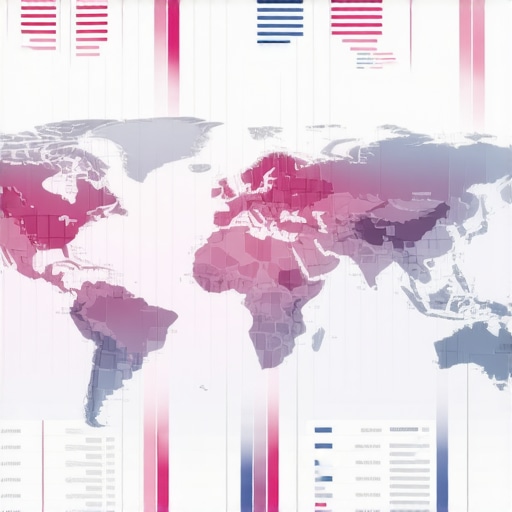My Personal Encounter with Maps Analytics & Rank Tracker
As someone who’s been dabbling in local SEO for years, I vividly remember the moment I realized that understanding Google Maps data could be a game-changer. I was struggling to outrank competitors in my neighborhood, despite having solid content and backlinks. That’s when I decided to dive into the world of Maps Analytics and Rank Trackers.
Initially, the data felt overwhelming, but I soon discovered that these tools provided invaluable insights into how my GMB (Google My Business) listings performed. I started tracking rankings daily and analyzing map interactions, which helped me identify patterns I never noticed before. It was like opening a window into my local customers’ behavior and search habits.
Why I Switched to Data-Driven Strategies for GMB Optimization
Before leveraging these analytics, I relied heavily on guesswork. I thought optimizing my GMB was just about adding keywords, photos, and responding to reviews. But I learned that maps analytics could tell me exactly what was working and what wasn’t. For example, I saw which keywords triggered the most map views and how my position fluctuated over time.
This insight prompted me to refine my local SEO strategies, focusing on high-impact keywords and optimizing my profile accordingly. As I monitored my rankings through a reliable rank tracker, I started seeing noticeable improvements in my local visibility.
How Do I Use These Tools Effectively?
What are the key metrics I should focus on?
Great question. From my experience, focusing on ranking position fluctuations, map impressions, and profile engagement are essential. Tracking these metrics consistently helped me understand the impact of my local SEO efforts, especially when combined with other data like customer reviews and photo views. It’s also vital to set benchmarks and compare your progress over time.
In addition, I found that integrating these insights into my SEO KPI dashboard allowed me to make smarter decisions and prioritize tasks effectively. The process is ongoing, but the clarity I gained made a huge difference.
My Personal Tips for Maximizing Local SEO with Maps Analytics & Rank Trackers
- Stay consistent with your tracking—daily if possible.
- Use data to identify keyword opportunities and gaps.
- Combine analytics with customer reviews for a comprehensive strategy.
- Regularly update your GMB profile based on insights.
If you’re serious about dominating local search, I strongly recommend exploring these tools further. They’ve transformed how I approach local SEO, and I believe they can do the same for you. And remember, it’s not just about rankings; it’s about understanding your audience and adapting your strategies accordingly.
For more expert tips, check out effective maps analytics strategies for 2025.
I’d love to hear your experiences with these tools. Feel free to leave a comment or share your success stories!
Beyond the Basics: How Advanced Maps Analytics Can Revolutionize Your Local SEO
While many local businesses utilize basic map insights, leveraging advanced analytics can provide a competitive edge. For instance, understanding the granularities of user interaction patterns on your GMB profile—such as hover durations, click paths, and search intent signals—can help tailor your content and local offerings more precisely. These insights, when integrated into a comprehensive SEO KPI dashboard, enable strategic decision-making rooted in real data rather than assumptions.
How Do You Measure Real Impact? Key Metrics for Expert-Level Local SEO
What metrics reveal true customer engagement and conversion potential?
In my experience, metrics like the conversion rate from map impressions to website visits, profile engagement duration, and calls or direction requests are critical indicators of local SEO effectiveness. Tracking these over time with a robust ranking tracker—such as the ones discussed in ranking tracker strategies for 2025—can uncover trends and opportunities often missed by surface-level analysis.
Moreover, correlating these metrics with external factors, such as local events or seasonal trends, enhances predictive accuracy. This holistic approach ensures your strategies remain agile and highly targeted.
Can You Personalize Local Strategies Using Geo-Behavior Data?
Absolutely. Geo-behavioral data—like popular times, frequent routes, or local competitor movements—can be integrated with your analytics dashboards to craft hyper-local marketing campaigns. For example, if analytics reveal that your target audience frequents specific areas during certain times, you can optimize your GMB posts, offers, and ad placements accordingly.
Incorporating these insights not only boosts visibility but also enhances user experience, fostering trust and loyalty. For a comprehensive guide on harnessing maps analytics for local market dominance, explore strategies for 2025.

Image depicting a detailed maps analytics dashboard with various user engagement metrics and geo-behavior data visualizations.
Why Is Continuous Optimization Critical in 2025?
The local SEO landscape is more dynamic than ever, with algorithm updates and shifting consumer behaviors. Regularly revisiting your data—using tools like GMB performance reports—ensures your strategies stay relevant and effective. Remember, what works today may need adjustment tomorrow, especially when relying on nuanced data insights.
If you’re eager to deepen your understanding, I recommend exploring the latest in local SEO report tools for 2025. They are invaluable for tracking your progress and identifying new opportunities.
What innovative tactics have you implemented recently using maps analytics? Share your experiences or ask for advice—your insights could help others elevate their local SEO game!
How Do Nuanced User Behavior Patterns Transform Your Local SEO Approach?
In my journey with maps analytics, I’ve come to realize that understanding surface-level metrics isn’t enough anymore. When I started digging deeper into user interaction patterns—like hover durations, click paths, and search intent signals—I uncovered insights that truly transformed my local SEO strategy. These nuanced behaviors revealed not just what users are doing, but why they’re doing it, allowing me to tailor my content and offerings more precisely.
For example, I noticed that many users hovered over my profile for extended periods but didn’t click through. This suggested they were seeking specific information, perhaps hours or directions, but weren’t finding it easily. By analyzing these signals, I optimized my GMB profile with clearer, more prominent contact and location info, which increased engagement and conversions. This approach, rooted in granular data, exemplifies how advanced analytics can elevate your local SEO efforts beyond generic tactics.
How Can You Leverage External Data to Enrich Your Maps Analytics?
One of the most revealing aspects of my experience has been integrating external data sources—like local events, seasonal trends, or even weather patterns—into my analytics dashboard. This holistic view provides context that pure search data can’t offer. For instance, during a local festival, I noticed a spike in map impressions and direction requests. Anticipating this, I prepared special offers and optimized my profile to capture the surge in local foot traffic.
According to recent insights shared in this article, blending external signals with internal analytics allows for more agile and targeted campaigns. It’s like having a weather forecast for your local market—knowing when and where to focus your efforts for maximum impact.
How Do You Maintain Data Privacy While Maximizing Insightfulness?
Personal experience has shown me that balancing data privacy with effective analytics is a delicate yet essential dance. While advanced maps analytics can provide incredibly detailed insights, respecting user privacy and abiding by policies like GDPR is paramount. I’ve adopted practices such as anonymizing data and focusing on aggregate trends rather than individual behaviors. This ensures I stay compliant while still extracting valuable, actionable insights.
For those interested in deepening their understanding of responsible data use, I recommend exploring our privacy policy and best practices outlined in recent industry reports. Trust and transparency not only safeguard your reputation but also foster customer loyalty—a vital asset in local SEO.
What’s Next in Your Maps Analytics Journey?
Looking ahead, I believe the future of maps analytics lies in integrating AI-powered predictive models. Imagine not just understanding current user behavior but also anticipating future trends—such as emerging search queries or shifting customer preferences. This proactive approach could give your local business a significant competitive edge.
For anyone eager to explore these advanced strategies, I encourage you to dive into the latest tools and reports like strategies for 2025. Continuous learning and adaptation are key, and I’m excited to see how these innovations will shape the next chapter of local SEO success.
Have you experimented with any of these advanced analytics techniques? I’d love to hear your stories or answer any questions—let’s grow our local businesses together!
Deciphering User Behavior: The Next Frontier in Maps Analytics
While foundational analytics provide valuable insights, delving into complex user interaction patterns unlocks a new realm of strategic advantage. For instance, analyzing hover durations over specific profile sections or click path sequences can reveal what information your audience values most. This granular understanding allows you to optimize your SEO KPI dashboard with precision, tailoring your content to meet evolving user expectations. Incorporating tools like heatmaps or session recordings—similar to those used in advanced web analytics—can further illuminate these subtle yet impactful behaviors, empowering you to craft hyper-targeted local marketing campaigns.
Integrating External Data Sources for Context-Rich Insights
External data integration is transforming how we interpret maps analytics. By overlaying local event calendars, weather patterns, or seasonal trends onto your analytics dashboard, you gain a contextual perspective that pure search data cannot offer. For example, during a regional festival, a spike in map impressions might occur, signaling an opportunity to boost special offers or update your profile for maximum visibility. According to recent industry insights, this holistic approach enhances predictive accuracy and campaign agility, enabling businesses to respond proactively rather than reactively. Exploring platforms like strategic reports for 2025 can guide you in harnessing these external signals effectively.
Addressing Data Privacy: Balancing Insight and Responsibility
As analytics become more sophisticated, maintaining trust through data privacy is paramount. My experience underscores the importance of anonymizing user data and focusing on aggregate trends—practices aligned with industry standards like GDPR. Not only does this safeguard your reputation, but it also ensures compliance while still deriving actionable insights. For those seeking a comprehensive understanding of responsible data use, reviewing our privacy policy and adhering to emerging best practices is essential. Striking this balance fosters transparency and nurtures long-term customer loyalty, integral to sustainable local SEO growth.
Embracing AI and Predictive Analytics for Future-Proof Strategies
The horizon of maps analytics is increasingly being shaped by artificial intelligence. Predictive models can analyze historical data to forecast emerging search trends, customer preferences, and even local market shifts. Imagine deploying AI algorithms to identify burgeoning neighborhoods or trending keywords before your competitors do—giving you a strategic head start. According to industry pioneers, integrating AI-driven insights into your strategic toolkit elevates your local SEO from reactive to proactive. I encourage you to experiment with emerging tools and share your experiences; the future belongs to those who leverage intelligent data for decisive action.
Join the Conversation: Elevate Your Local SEO Game
If you’re eager to deepen your mastery of these advanced analytics techniques, don’t hesitate to reach out through our contact page. Sharing insights and experiences fosters a community of growth-minded local marketers. Remember, continuous learning and adaptation are vital—especially as the digital landscape evolves rapidly. Your next breakthrough could be just a data point away, so stay curious and proactive. Together, we can redefine local SEO excellence in 2025 and beyond.
Things I Wish I Knew Earlier (or You Might Find Surprising)
1. Hidden Power of User Behavior
Early on, I underestimated how much nuanced user interaction data—like hover durations and click paths—could tell me about my audience. Once I started paying attention to these subtle signals, I discovered opportunities to optimize my GMB profile that I hadn’t considered before, leading to better engagement.
The Importance of External Data
Integrating local weather, events, and seasonal trends into my analytics provided a richer context for interpreting map impressions and search patterns. This holistic view helped me anticipate customer needs during specific times, making my local SEO efforts more proactive than reactive.
Data Privacy Is Not a Barrier, But a Responsibility
Initially, I feared that digging deeper into analytics might compromise user privacy. However, adopting anonymized data and focusing on aggregate trends allowed me to gain valuable insights without crossing ethical lines. This approach fostered trust and sustained my long-term strategy.
Continuous Learning Is Key
The digital landscape evolves rapidly. Staying updated with tools, industry reports, and best practices—like those I found at our privacy policy—ensures my strategies remain effective. I wish I’d embraced this mindset earlier, as it would have saved me time and effort.
Embracing AI and Predictive Analytics
Looking ahead, I see AI-driven insights transforming local SEO. Forecasting trends and customer behaviors before they happen excites me, and I recommend exploring tools that incorporate predictive analytics, such as those discussed in strategies for 2025. It’s a game-changer for staying ahead.
Resources I’ve Come to Trust Over Time
- Google’s Official Resources: Google’s own support pages and updates are gold standards for understanding how Maps and GMB work. They keep me aligned with platform changes.
- Local Search Association: Their industry reports and webinars offer deep insights and real-world case studies, which I find incredibly helpful.
- Search Engine Journal: Regularly updated with the latest SEO trends, their articles help me adapt my strategies quickly and confidently.
Parting Thoughts from My Perspective
Reflecting on my journey, I realize that leveraging maps analytics and rank trackers has profoundly transformed my approach to local SEO. The key takeaway? Data-driven strategies, combined with a commitment to continuous learning and ethical practices, are essential for sustainable success in 2025 and beyond. If this resonates with you, I’d love to hear your thoughts or experiences. Share it with someone who might find it helpful, and let’s grow our local businesses together!


